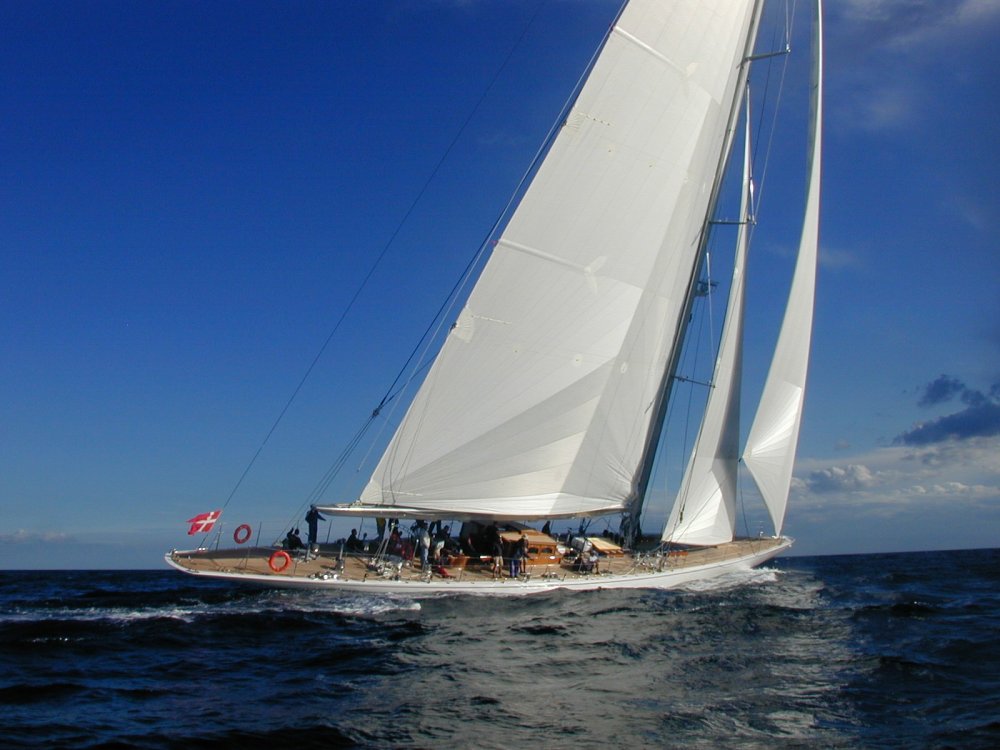
J-Class Ranger to race in Rolex Transatlantic Challenge 2005
by Barby MacGowan 28 Jan 2004 13:28 GMT

The J-Class yacht 'Ranger' is to race in the Rolex Transatlantic Challenge 2005 © NYYC / Rolex
The New York Yacht Club (NYYC) announced today that Ranger, a re-creation of the legendary J-Class yacht that won the 1937 America’s Cup, will race in the Rolex Transatlantic Challenge 2005. The first Ranger was described in 1939 by Harold S. “Mike” Vanderbilt, her skipper and a three-time winner of the America’s Cup, as “the fastest all-around sailing vessel that has ever been built.”
The Rolex Transatlantic Challenge, hosted by the NYYC with the cooperation of England’s Royal Yacht Squadron, is for the world’s largest monohull yachts. A theme of the race is to break the 100-year-old transatlantic-race record of Atlantic, skippered by the notable Charlie Barr. In 1905 the 185-foot (56.4m) Atlantic raced from New York to the Lizard in England in 12 days, four hours, one minute and 19 seconds. That is the oldest race record in sailing.
Eleven yachts have already expressed their intention to enter the Rolex Transatlantic Challenge at this early date. The race, to start off New York on May 21, 2005, is for monohull yachts 70 feet (21.34m) length on deck or greater. There is no maximum size.
The owner of the new Ranger is John Williams, a NYYC member. The contemporary Ranger – an amalgamation of the old and new -- is, in fact, a card-carrying member of the J Class.
Only 10 – now 11 – J-Class yachts have ever been built; three – now four – survive plus Cambria that was later converted. The Js raced for the America’s Cup from 1930 to 1937, a period of three defenses, all won by Mike Vanderbilt, commodore of the NYYC (1922-24).
This Ranger was designed first by Paolo Scanu, who co-designed the owner’s Georgia. Then, yacht designer Reichel Pugh focused on sailing systems, deck layout, rig size and some rig- and sheet-load calculations, as well as the size of the rudder.
While the 1937 edition was engineless, more or less without accommodations and towed to the starting line, the new version is designed to modern super-yacht standards. She is British MCA (Marine and Coast Guard Agency)- and Lloyds- compliant.
Both Rangers measure 136 feet (41.5m) overall. The waterline on the new Ranger is 91 feet (27.7m) – now the maximum racing-waterline length for the class -- versus the aforementioned 87 feet. That is a function primarily of the amenities. The freeboard is four inches higher -- this was permitted by the J-Class Association for reasons of headroom and to make up for the headroom consumed by the gears of coffee-grinder winches. There is a doghouse, now common to her brethren, made of carbon fiber.
Other firm entries are Mari-Cha IV and Sumurun. Last year, the 140-foot (42.7m) carbon-fiber canting-keel Mari-Cha IV (left), skippered by Robert Miller, of the Royal Yacht Squadron, Cowes, set the west-to-east transatlantic-passage record of six days, 17 hours, 52 minutes and 39 seconds. During this record-breaking crossing, Robert Miller and his crew also shattered the 24-hour distance record by sailing 525.7 nautical miles. Writing about these feats, the Wall Street Journal headlined its (October 9) article: “Bob Miller Wanted the World's Fastest Sailboat -- And He May Have It.”
Sumurun is skippered by A. Robert Towbin, chair of the NYYC’s Rolex Transatlantic Challenge Committee. In 1997, his 94-foot (28.7m) Fife design (below), built in 1914, won the Classic Division in the Atlantic Challenge Cup, this race’s predecessor.
There will be at least three divisions: Classic, Performance Cruising and Grand Prix. Beyond looking to break Atlantic’s record, yachts will race for elapsed time as well as handicap prizes. The classics will race under the NYYC Cruising Rule; the Performance Cruising and Grand Prix yachts will race under Americap II or IRC. The race is registered with the World Sailing Speed Record Council, part of ISAF, in case the record of Atlantic is broken.
Prior to departure, owners and guests will be entertained at the New York Yacht Club in New York City and aboard the aircraft carrier and museum USS Intrepid in New York Harbor where the entrants will be berthed.
The 2005 race will have two finish lines: The first will be off Lizard light, to mark Atlantic’s existing race record. After passing through the Lizard finish gate, yachts will continue racing to the second finish line, located at the Needles Fairway buoy, off the Isle of Wight. This adds about 142 nautical miles to the distance to the Lizard, bringing the total race distance to about 3,142 nm. Atlantic’s race record for the latter course is 13 days, 10 hours and 15 minutes.
When the fleet arrives in England, it will be welcomed by the Royal Yacht Squadron (RYS). A highlight of the post-race festivities will be a race around the Isle of Wight, where in 1851, America, a yacht representing the NYYC, raced a fleet of RYS vessels in what became known as the “America’s Cup.” In honor of its 150th Anniversary, the Round the Island Race was the centerpiece of the now-famous America’s Cup Jubilee, hosted by the RYS and NYYC in 2001. The 2005 Rolex Race Around the Isle of Wight, hosted by the RYS, will be reserved for yachts that participated in the Rolex Transatlantic Challenge. Visiting yachts will also take part in England’s celebration of the 200th anniversary of the Battle of Trafalgar.
More Information: